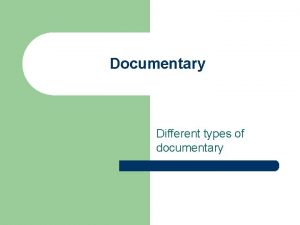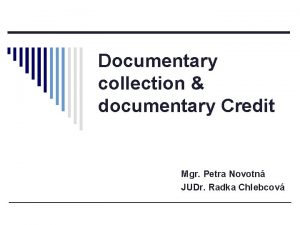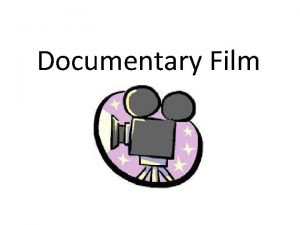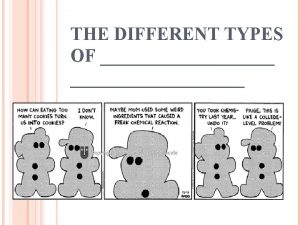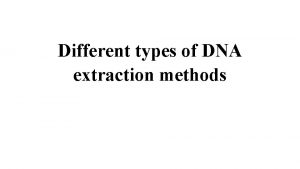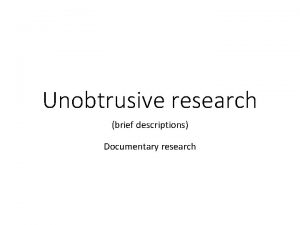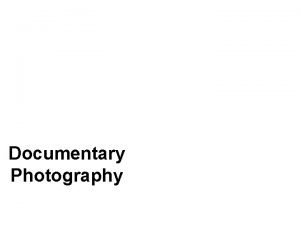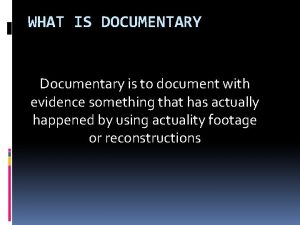Documentary Different types of documentary Documentary research unit










- Slides: 10

Documentary Different types of documentary

Documentary research unit 2 Task 1 l Secondary Research : – l l Audio-visual products Using examples from class and from your own findings, explain the key techniques used to make a documentary. Identify at least four kinds of documentary and explain how they have changed over time. To achieve a distinction aim to identify at least six kinds of documentary.

Two major approaches You can generally categorise documentary into two major approaches: 1. History and biography: Dealing with events of the past, usually involving some re-creation. 2. Filming behaviour: intending to portray different groups of people and are usually contemporary.

1. Modes of documentary-The Expository Mode l The expository documentary uses a narrator to address the audience directly and to present an exposition, or explanation, interpreting what they are seeing on screen. Because of the disembodied nature of the narration, this form of documentary is sometimes known as the voice-of-God mode. This is one of the oldest forms of documentary and one of the most established conventions. Programmes such as Big Brother and its follow-ups (Channel 4, 2000 -2002) still use the voice-of-God narration, in the form of voice-overs by one of the producers, in order to interpret the material we are watching. Whether or not the narrator is represented visually, we are expected to trust the narration as a definitive interpretation of, or anchor for the visual material and to accept it as authoritative on the subject matter.

2. The Expository Mode continued. l l l In order to make this kind of identification easier, the narrator will often represent the target audience for the programme (which frequently means a male, white, middle-class narration) and will address them as a group who share the implied values of the text. On occasions, the narration of a documentary is shared between a number of people, as experts, witnesses or participants. This kind of narration is known as talking heads mode, describing the characteristic medium close-up shot which is used to frame the individual. This approach is often used in programmes such as Emergency 999 or Crimewatch (BBC) where a number of different perspectives on a single incident are available.

3. The Observational Mode l The Observational Mode (as technology advanced by the 1960 s and cameras became smaller and lighter, able to document life in a less intrusive manner, there is less control required over lighting etc, leaving the social actors free to act and the documentarists free to record without interacting with each other)

4. The Participatory mode l The Participatory Mode (the encounter between film-maker and subject is recorded, as the film-maker actively engages with the situation they are documenting, asking questions of their subjects, sharing experiences with them. Heavily reliant on the honesty of witnesses)

5. The reflexive mode l The Reflexive Mode (demonstrates consciousness of the process of reading documentary, and engages actively with the issues of realism and representation, acknowledging the presence of the viewer and the modality judgements they arrive at. Corresponds to critical theory of the 1980 s)

6. The Performative mode l The Performative Mode (acknowledges the emotional and subjective aspects of documentary, and presents ideas as part of a context, having different meanings for different people, often autobiographical in nature)

Task For each of the documentaries you have been studying, try to categorise them into the mode they use.
 What is expository documentary
What is expository documentary Documentary collection vs documentary credit
Documentary collection vs documentary credit Documentary collection vs documentary credit
Documentary collection vs documentary credit Type of study design in research
Type of study design in research Unit 10, unit 10 review tests, unit 10 general test
Unit 10, unit 10 review tests, unit 10 general test Why do different polymers have different properties?
Why do different polymers have different properties? Why do different atoms produce different colors
Why do different atoms produce different colors Sound will travel at different speeds in different mediums.
Sound will travel at different speeds in different mediums. Library.thinkquest.org 19537
Library.thinkquest.org 19537 Different culture have different moral codes
Different culture have different moral codes Different angle different story
Different angle different story
